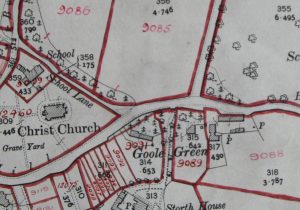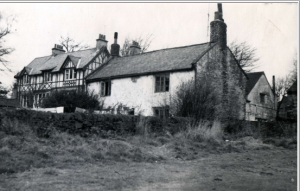Ownership
From the Land Tax Assessments completed in the early C20th we know that the land (9088) was owned by Thomas Kingsford Wilson who was the son-in-law of Henry Dixon of Stumperlowe Hall. Wilson also owned the field below (9089). Henry Isaac Dixon owned much of the land in Fulwood and had sold the two fields to Wilson in 1907. As we shall see, Wilson was a key player in the conversion of the Guildhall. The Assessment also tells us that Westby leased both fields 9088 and 9089 and he may well have sub-let the field for grazing.

Land Tax Assessment 1912. The numbers in red show the reference in the LTA Field Book
Conversion to a Guild Hall.
The majority of the rest of this article is based on newspaper ‘snippets’ which may well have been provided by the Guild. The other source is Tom Dakin’s account of the Fulwood Sports Club written for its centenary in 2010. Dakin (born about 1930) is clearly speaking from personal knowledge and experience, although he is not always correct.
The barn was transformed into the home of the Fulwood Social Guild early in the C20th. The local newspapers first printed reports of the Guild in 1908 – an evening of song, sketches and a cinematograph show. Dakin says the Guild was a ‘farmer’s guild’ but from its first report the Telegraph refers to it as the Fulwood Social Guild’. A year later the Fulwood Musical Society was inaugurated with C D Leng (owner of the Sheffield Telegraph) as one of the vice presidents. Meanwhile, work to transform the building from a barn to a suitable venue was underway, funded, according to Dakin, by Wilson. This was to be more than a simple room and there is still evidence of the transformation the final layout.
At the western end a stage was erected with steps up from the floor. Below the stage was a space for storing scenery and props and behind the stage were dressing rooms on an upper floor. At the eastern end a balcony was erected with tiered seating. The door at the eastern end of the north wall and the one on the eastern wall gave access to the balcony and both opened outwards. The present owners told me that the lifting gear for the flats and scenery were still present when they bought the place in the 1970s. It was possibly at this time that the small rectangular extension at the eastern end was built. This had a simple urinal consisting of a cemented wall and gulley and was open to the sky. This basic provision was still in evidence when the present owners moved in but evidence of further provision was not. The conversion included catering facilities behind the stage at ground level.
The Guildhall was opened in November 1909 (Dakin gave 1912). Finance for the conversion had come from Thomas Kingsford Wilson. Dakin says Wilson gave the barn to the Social Guild but this is not corroborated by the newspapers, so it is likely that the Guild came to an arrangement with Wilson, possibly a rent of £20 per year. The newspaper report said Wilson presented the Guild with £20 which paid the first year’s rent. The conversion was not complete as there was still about £200 of furnishings but there was only £78 in the bank. Thereafter concerts were a regular feature along with children’s parties at Christmas and dancing classes. Occasionally the Guildhall was the venue for a wedding reception.

Goole Green Farm with Storth Cottage in the background on the left and the Guildhall behind
At some point (Dakin suggests the start of WW1) it was upgraded to act as a cinema. The projectionist accessed the projectors via a door at the eastern end of the southern wall. Unfortunately, the newspapers do not have any references to a Fulwood Cinema but Dakin says there were film shows during the winter months. The development of sound films in the late 1920s led to the demise of the cinema in Fulwood.
